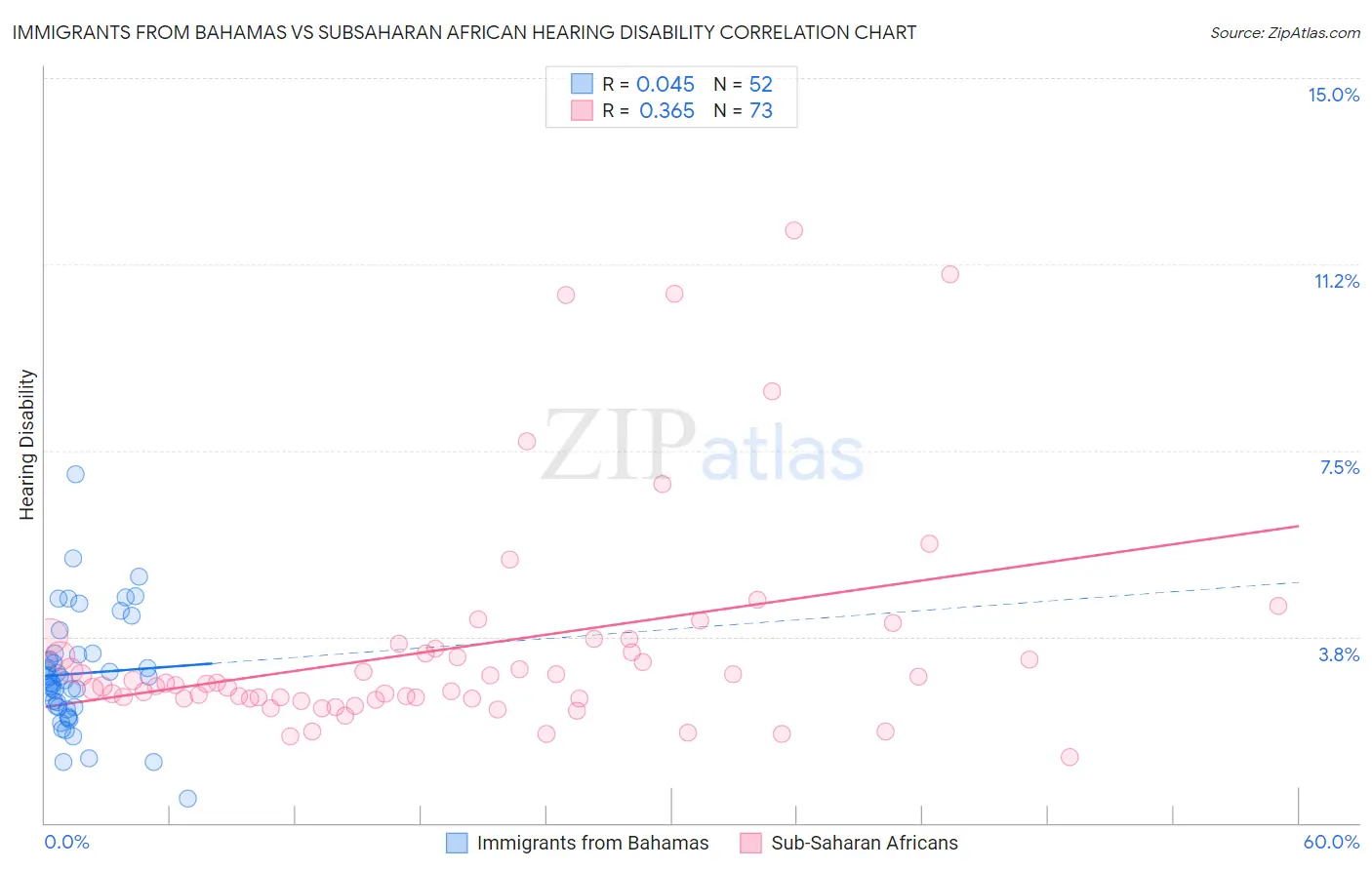Immigrants from Bahamas vs Subsaharan African Hearing Disability
COMPARE
Immigrants from Bahamas
Subsaharan African
Hearing Disability
Hearing Disability Comparison
Immigrants from Bahamas
Sub-Saharan Africans
2.9%
HEARING DISABILITY
80.9/ 100
METRIC RATING
143rd/ 347
METRIC RANK
2.9%
HEARING DISABILITY
83.3/ 100
METRIC RATING
141st/ 347
METRIC RANK
Immigrants from Bahamas vs Subsaharan African Hearing Disability Correlation Chart
The statistical analysis conducted on geographies consisting of 104,634,972 people shows no correlation between the proportion of Immigrants from Bahamas and percentage of population with hearing disability in the United States with a correlation coefficient (R) of 0.045 and weighted average of 2.9%. Similarly, the statistical analysis conducted on geographies consisting of 507,755,219 people shows a mild positive correlation between the proportion of Sub-Saharan Africans and percentage of population with hearing disability in the United States with a correlation coefficient (R) of 0.365 and weighted average of 2.9%, a difference of 0.39%.

Hearing Disability Correlation Summary
| Measurement | Immigrants from Bahamas | Subsaharan African |
| Minimum | 0.49% | 1.3% |
| Maximum | 7.0% | 11.9% |
| Range | 6.5% | 10.6% |
| Mean | 3.0% | 3.5% |
| Median | 2.9% | 2.8% |
| Interquartile 25% (IQ1) | 2.3% | 2.5% |
| Interquartile 75% (IQ3) | 3.4% | 3.6% |
| Interquartile Range (IQR) | 1.1% | 1.0% |
| Standard Deviation (Sample) | 1.2% | 2.2% |
| Standard Deviation (Population) | 1.1% | 2.2% |
Demographics Similar to Immigrants from Bahamas and Sub-Saharan Africans by Hearing Disability
In terms of hearing disability, the demographic groups most similar to Immigrants from Bahamas are Laotian (2.9%, a difference of 0.020%), Immigrants from Bulgaria (2.9%, a difference of 0.27%), Immigrants from Congo (2.9%, a difference of 0.31%), Brazilian (2.9%, a difference of 0.33%), and Tongan (2.9%, a difference of 0.35%). Similarly, the demographic groups most similar to Sub-Saharan Africans are Immigrants from Jordan (2.9%, a difference of 0.070%), Bermudan (2.9%, a difference of 0.090%), Immigrants from Costa Rica (2.9%, a difference of 0.13%), Sri Lankan (2.9%, a difference of 0.14%), and Immigrants from Brazil (2.9%, a difference of 0.24%).
| Demographics | Rating | Rank | Hearing Disability |
| Chileans | 85.8 /100 | #132 | Excellent 2.9% |
| Immigrants | Syria | 85.8 /100 | #133 | Excellent 2.9% |
| Ugandans | 85.5 /100 | #134 | Excellent 2.9% |
| Soviet Union | 84.8 /100 | #135 | Excellent 2.9% |
| Immigrants | Brazil | 84.6 /100 | #136 | Excellent 2.9% |
| Sri Lankans | 84.1 /100 | #137 | Excellent 2.9% |
| Immigrants | Costa Rica | 84.0 /100 | #138 | Excellent 2.9% |
| Bermudans | 83.8 /100 | #139 | Excellent 2.9% |
| Immigrants | Jordan | 83.7 /100 | #140 | Excellent 2.9% |
| Sub-Saharan Africans | 83.3 /100 | #141 | Excellent 2.9% |
| Laotians | 81.1 /100 | #142 | Excellent 2.9% |
| Immigrants | Bahamas | 80.9 /100 | #143 | Excellent 2.9% |
| Immigrants | Bulgaria | 79.2 /100 | #144 | Good 2.9% |
| Immigrants | Congo | 78.9 /100 | #145 | Good 2.9% |
| Brazilians | 78.7 /100 | #146 | Good 2.9% |
| Tongans | 78.6 /100 | #147 | Good 2.9% |
| Immigrants | Russia | 77.7 /100 | #148 | Good 2.9% |
| Immigrants | Panama | 76.9 /100 | #149 | Good 2.9% |
| Palestinians | 73.6 /100 | #150 | Good 2.9% |
| Immigrants | France | 73.1 /100 | #151 | Good 2.9% |
| Immigrants | Lithuania | 73.0 /100 | #152 | Good 2.9% |